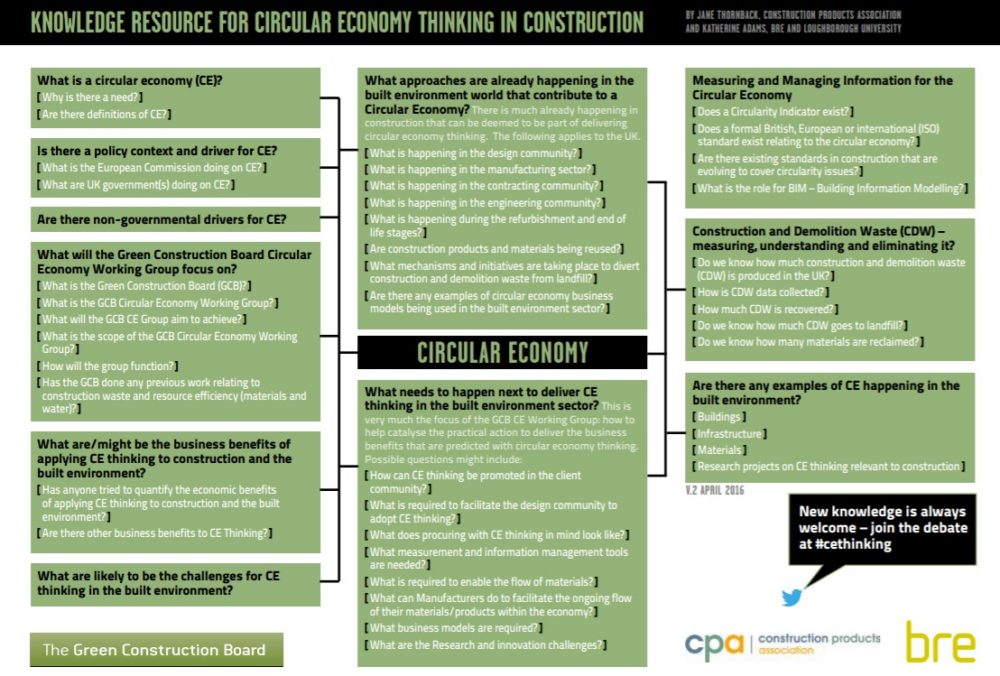
What the Circular Economy Might Mean for the Construction Industry
We live in a small highly developed island and so the built environment has a huge impact not only on where we live and work but also in how we travel around, how we communicate and even how our country’s economy is shaped. Buildings have evolved over centuries, indeed millennia, and in themselves use a large amount of our natural resources both when they are built and when they are occupied or used. They also tend to be around for a long time and so, unlike consumer goods for example, it matters not just how we build them now but how they will operate for many years to come.
So for those of us who get involved in major construction projects, including the stakeholders who are consulted on them, there is a lot happening that will ensure that the built environment we are delivering today for us and future generations will have a lighter footprint. Choices that do need to be made can be done so consciously as every decision is about weighing up and balancing off social, environmental and economic priorities. At the cutting edge the construction of infrastructure and complex buildings today is a sophisticated operation where even before the earth is broken the building has been designed digitally and the data of each component has its environmental product data mapped to allow choices to be made to deliver best value for now and the future. So the big question is, can the modern built environment and its component parts be designed to be more efficient, last longer, be better used, and be available for similar or alternate purposes at end of life and to play a role in moving the UK towards being a successful circular economy?
Much of the work to develop circular economy thinking has to date has been focused on short-lived consumer goods such as phones, computers, washing machines, etc. Can this thinking be adapted so it can be applied to complex buildings and infrastructure that exist for decades, if not centuries? Circular economy thinking means maintaining access to materials and resources for continual and future use. To some extent for the construction industry it is still early days; to help navigate through the numerous initiatives and schemes to map the circular economy my organisation has developed an interactive “Knowledge Resource”. This also provides easy access to the many challenges and opportunities that the concept poses for construction as well as to the many, many strands of activity that are required to implement circular economy thinking in construction.

Knowledge resources for circular economy thinking in construction, by Jane Thornback, Construction Products Association, and Katherine Adams, BRE and Loughborough University.
Feel free to explore this map and use it to help ask questions about developments in your region, or if you are running a project use it to help identify opportunities to do things differently.
One example of how this thinking is being placed at the centre of a major project is High Speed Two (HS2 Ltd). They are identifying the existing work linked to circular economy that is relevant to their scheme and seeking opportunities which they can evaluate and prioritise to understand where circular economy principles can be further embedded to deliver value for the programme. They are looking to carry out a strategic assessment that places the business case at the heart of the study; focuses on specific changes that HS2 Ltd. can implement (as opposed to generic approaches); and identifies opportunities which would deliver quantifiable cost savings linked to better use of resources. It’s a huge and controversial project but by genuinely embedding a circular economy approach into their project right from the design stage they will certainly be making better choices in the construction and operation of the project than they would have without paying such attention to circular economy thinking.
It is early days for truly using circular economy thinking but taken together with the digitalisation of the sector and the move to smart buildings there is every chance that we will see major changes in the way our new infrastructure is both built and operated which will improve the sustainability performance of the project. For stakeholders and clients alike it is important that they are open to these new approaches and encourage our industry to continue to move forward and adopt the new approach.
Dr Diana Montgomery
References:
1 – Knowledge resources for circular economy thinking in construction, by Jane Thornback, Construction Products Association, and Katherine Adams, BRE and Loughborough University.
Author Bio:
Dr Diana Montgomery is Chief Executive of the Construction Products Association. The CPA’s role is to champion the importance of UK construction product manufacturing and distribution and represents 85% of the £50 billion sector by value, including global multinationals and 21,000 SMEs across the UK.
Diana is also the non-executive chair the board of the Institute of Environmental Management and Assessment.
Before joining the Construction Product Association, Diana was Deputy Chief Executive of the Chemical Industries Association where she raised the profile of chemical manufacturing in the UK and established its pivotal role in the delivery of the UK government’s sustainability targets. Previously she headed the sustainability agendas in companies including Centrica, the AA and Johnson Wax.
Diana is a Fellow of the Institute of Environmental Management and Assessment and the Royal Society of Chemistry. She has a degree from Oxford University in Chemistry and a PhD from Imperial College in Environmental Management.